
Acianthus fornicatus, commonly known as bristly mosquito orchid or pixie caps, is a species of flowering plant in the orchid family Orchidaceae and is endemic to eastern Australia. It is a terrestrial herb with a single, heart-shaped leaf and up to ten translucent pinkish-red flowers, and is widespread and common in coastal and near-coastal areas.

Acianthus amplexicaulis, is a species of flowering plant in the orchid family Orchidaceae and is native to eastern Australia and New Caledonia. The Australian Plant Census accepts the name Stigmotodactylus amplexicaulis(F.M.Bailey) S.P.Lyon, M.A.Clem. & D.L.Jones and the National Herbarium of New South Wales Acianthella amplexicaulis(F.M.Bailey) D.L.Jones and M.A.Clem. It is a terrestrial herb with a single leaf and between 2 and 20 translucent green flowers.
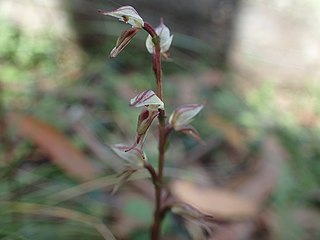
Acianthus apprimus, commonly known as early mosquito orchid, is a species of flowering plant in the orchid family Orchidaceae and is endemic to New South Wales in Australia. It is a terrestrial herb with a single, heart-shaped leaf and between two and nine translucent pinkish flowers with reddish markings and is found in disjunct populations around the state.
Acianthus borealis, commonly known as northern mosquito orchid, is a species of flowering plant in the orchid family Orchidaceae and is endemic to Queensland in Australia. It is a glabrous, terrestrial herb with a single, heart-shaped leaf and between two and twenty transparent pinkish flowers with reddish markings and is widely distributed on the eastern tablelands.

Acianthus collinus, commonly known as hooded mosquito orchid or inland mosquito orchid, is a species of flowering plant in the orchid family Orchidaceae and is endemic to south-eastern continental Australia. It is a terrestrial herb with a single, heart-shaped leaf and between two and nine translucent pinkish flowers with reddish markings and is found growing in colonies on sheltered slopes in open forest in on the western slopes of the Great Dividing Range.
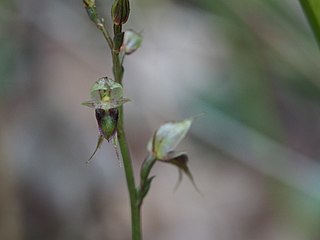
Acianthus exiguus, commonly known as tiny mosquito orchid, is a flowering plant in the orchid family Orchidaceae and is endemic to New South Wales in Australia. It is a terrestrial herb with a single, heart-shaped leaf and up to five translucent greenish-white flowers with pinkish markings and is found growing in forests on the north coast of the state.

Acianthus exsertus, commonly known as gnat orchid or large mosquito orchid, is a species of flowering plant in the orchid family Orchidaceae and is endemic to eastern Australia. It is a terrestrial herb with a single, heart-shaped leaf and up to 25 small, fine, dark brown flowers with pinkish and purplish markings and is found growing in sheltered places in forests in Queensland, New South Wales the ACT and Victoria.
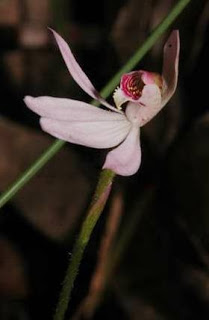
Caladenia curtisepala, commonly known as short-hooded fingers, is a plant in the orchid family Orchidaceae and is endemic to south-eastern Australia. It is a ground orchid with a single hairy leaf, and a single white to cream-coloured flower with a white labellum with red bands.
Caladenia saxatilis is a plant in the orchid family Orchidaceae and is endemic to South Australia. It is a ground orchid with a single hairy leaf and one or two pale creamy-green flowers, sometimes with thin reddish lines. It occurs in the southern Flinders Ranges.
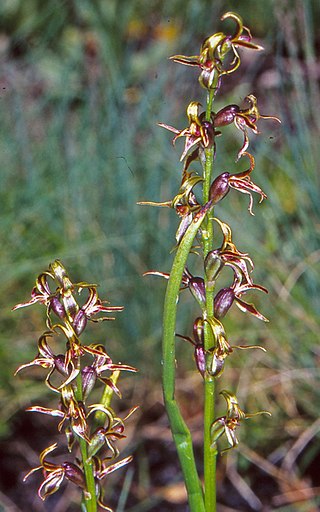
Prasophyllum sphacelatum, commonly known as the subalpine leek orchid, is a species of orchid endemic to south-eastern Australia. It has a single tubular, dull green leaf and up to eighteen scented, green to brownish flowers with a green to pinkish labellum. It grows in subalpine areas of New South Wales, Victoria and Tasmania.

Prasophyllum dossenum is a species of orchid endemic to a small area of northern New South Wales. It has a single tubular, dark green leaf and up to thirty scented pinkish-white and greenish-brown flowers crowded along an erect flowering stem. It is a rare orchid which grows in grassy places on the Northern Tablelands of New South Wales.

Acianthus caudatus, commonly known as mayfly orchid, is a species of flowering plant in the orchid family Orchidaceae and is endemic to eastern Australia. It is a terrestrial herb with a single egg-shaped or heart-shaped leaf and up to nine dark purplish flowers with thin, spreading sepals and petals, often with a musty odour.
Prasophyllum readii, commonly known as the Streathem leek orchid, is a species of orchid endemic to Victoria. It has a single, tubular leaf and up to twenty five scented, greenish-brown to reddish-brown flowers with a white or pinkish labellum and is only known from a swamp in the south-west of the state.
Genoplesium confertum, commonly known as the crowded midge orchid, is a small terrestrial orchid endemic to the south-east of Queensland. It has a single thin leaf fused to the flowering stem and up to sixty small, densely crowded, reddish and green flowers and grows in coastal heath.
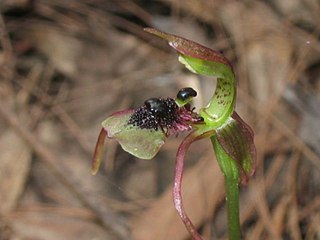
Chiloglottis seminuda, commonly known as the turtle orchid, is a species of orchid endemic to south-eastern New South Wales. It has two broad leaves and a single green or reddish pink flower with a shiny black insect-like callus covering two-thirds of the base of the labellum but with the tip of the labellum free of callus.
Corybas × miscellus, commonly known as the hybrid helmet orchid, is a hybrid species of terrestrial orchid endemic to South Australia and a very small area in far western Victoria. It has a heart-shaped to more or less round leaf and a single reddish purple flower with greyish translucent areas. It is a natural hybrid between C. diemenicus and C. incurvus and shares the characteristics of the parent species.

Eriochilus magenteus, commonly known as the magenta autumn orchid, is a plant in the orchid family Orchidaceae and is endemic to south eastern Australia. It is a slender ground orchid with a single leaf and one or two small, bright pink to magenta flowers. It is only found in higher areas of the Australian Capital Territory, southern New South Wales and north-eastern Victoria.

Acianthus cuneatus, commonly known as New England mosquito orchid, is a species of flowering plant in the orchid family Orchidaceae and is endemic to the Northern Tablelands of New South Wales. It is a terrestrial herb with a single, heart-shaped leaf and up to seven translucent greenish flowers with purplish stripes and is found growing in sheltered slopes in open forest.
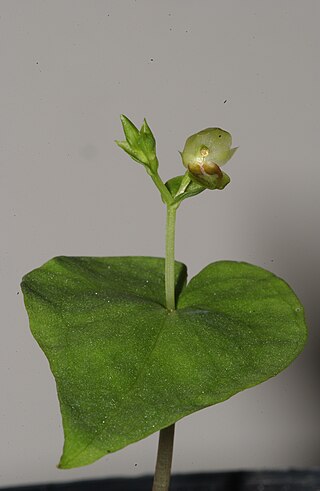
Acianthus saxatilis is a species of flowering plant in the orchid family Orchidaceae and is endemic to Queensland. It is a terrestrial herb with a single, relatively large, heart-shaped leaf and usually up to 5 translucent greenish-brown to greenish-yellow flowers.
Genoplesium cuspidatum is a species of small terrestrial orchid endemic to eastern Australia. It has a single leaf fused to the flowering stem and between 6 and 28 reddish to dark purple flowers with prominent darker stripes.














